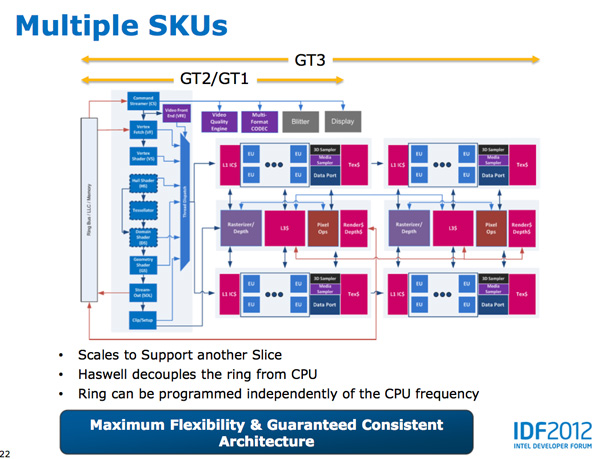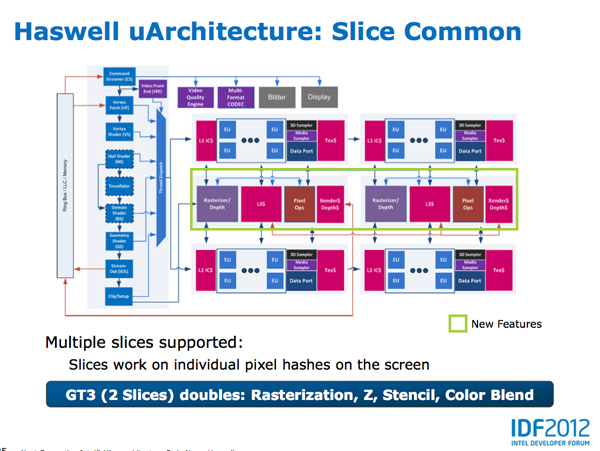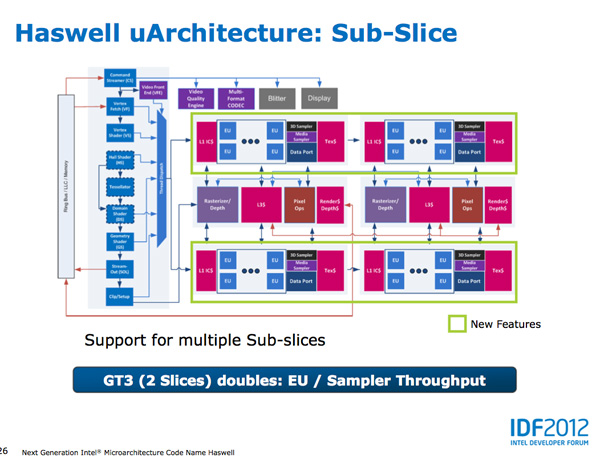Intel's Haswell Architecture Analyzed: Building a New PC and a New Intel
by Anand Lal Shimpi on October 5, 2012 2:45 AM ESTHaswell's GPU
Although Intel provided a good amount of detail on the CPU enhancements to Haswell, the graphics discussion at IDF was fairly limited. That being said, there's still some to talk about here.
Haswell builds on the same fundamental GPU architecture we saw in Ivy Bridge. We won't see a dramatic redesign/re-plumbing of the graphics hardware until Broadwell in 2014 (that one is going to be a big one).
Haswell's GPU will be available in three physical configurations: GT1, GT2 and GT3. Although Intel mentioned that the Haswell GT3 config would have twice the shader count of Haswell GT2, it was careful not to disclose the total number of EUs in any of the versions. Based on the information we have at this point, GT3 should be a 40 EU configuration while GT2 should feature 20 EUs. Intel will also be including up to one redundant EU to deal with the case where there's a defect in an EU in the array. This isn't an uncommon practice, but it does indicate just how much of the die will be dedicated to graphics in Haswell. The larger of an area the GPU covers, the greater the likelihood that you'll see unrecoverable defects in the GPU. Redundancy at the EU level is one way of mitigating that problem.
Haswell's processor graphics extends API support to DirectX 11.1, OpenCL 1.2 and OpenGL 4.0.
At the front of the graphics pipeline is a new resource streamer. The RS offloads some driver work that the CPU would normally handle and moves it to GPU hardware instead. Both AMD and NVIDIA have significant command processors so this doesn't appear to be an Intel advantage although the devil is in the (unshared) details. The point from Intel's perspective is that any amount of processing it can shift away from general purpose CPU hardware and onto the GPU can save power (CPU cores go to sleep while the RS/CS do their job).
Beyond the resource streamer, most of the fixed function graphics hardware sees a doubling of performance in Haswell.
At the shader core level, Intel separates the GPU design into two sections: slice common and sub-slice. Slice common includes the rasterizer, pixel back end and GPU L3 cache. The sub-slice includes all of the EUs, instruction caches and EUs.
In Haswell GT1 and GT2 there's a single slice common, while GT3 sees a doubling of slice common. GT3 similarly has two sub-slices, although once again Intel isn't talking specifics about EU counts or clock speeds between GT1/2/3.
The final bit of detail Intel gave out about Haswell's GPU is the texture sampler sees up to a 4x improvement in throughput over Ivy Bridge in some modes.
Now to the things that Intel didn't let loose at IDF. Although originally an option for Ivy Bridge (but higher ups at Intel killed plans for it) was a GT3 part with some form of embedded DRAM. Rumor has it that Apple was the only customer who really demanded it at the time, and Intel wasn't willing to build a SKU just for Apple.
Haswell will do what Ivy Bridge didn't. You'll see a version of Haswell with up to 128MB of embedded DRAM, with a lot of bandwidth available between it and the core. Both the CPU and GPU will be able to access this embedded DRAM, although there are obvious implications for graphics.
Overall performance gains should be about 2x for GT3 (presumably with eDRAM) over HD 4000 in a high TDP part. In Ultrabooks those gains will be limited to around 30% max given the strict power limits.
As for why Intel isn't talking about embedded DRAM on Haswell, your guess is as good as mine. The likely release timeframe for Haswell is close to June 2013, there's still tons of time between now and then. It looks like Intel still has a desire to remain quiet on some fronts.














245 Comments
View All Comments
tim851 - Friday, October 5, 2012 - link
This is a perfect demonstration of the power of competition.With AMD struggling badly, Intel was content in pushing Atom. They didn't want to innovate in that sector, they sold 10 year old technology with horribly outdated chipsets. Yes, they were relatively cheap, but I was appalled.
Step in ARM, suddenly becoming a viable competitor. Now Intel moves its fat ass and tries to actually build something worthwhile.
Sadly, free markets are an illusion. Intel should pay dearly for the Atom fiasco, but they won't. Just as they didn't pay for the Pentium 4 debacle. They will come 5 years late to the party, but with all their might, they will crush ARM. ARM will fall behind, they can't keep up with that viscious tick-tock-cycle. Who can?
In 8 years, ARM will have been bought by some company, perhaps Apple. ARM will then no longer be a competitor, it will be just a different architecture, like X86. I don't see Apple having any long-term interest in designing their own hardware, it's way too unsexy. They will just cross-licence ARM with Intel and in 10 years time, Intel will rule supremely again.
UpSpin - Friday, October 5, 2012 - link
You forget that Intel vs. ARM is something bigger than AMD vs. Intel.Behind ARM stand Qualcomm, Samsung, Apple, ...
All new software is written for ARM, not Intel (x86) any longer. Microsoft releases a rewritten ARM Windows RT with a rewritten Office for ARM. Android runs on ARM and everyone supports the ARM version, while only Intel has to keep it compatible with x86.
Haswell will get released, when exactly? In a year, ARM A15 in maybe two months. Haswell has nice power savings, but it's still a Ultrabook design. The current Atom SoCs are much worse than current A9/Krait SoCs. Intel heavily optimized the software to make it look not that bad (excellent Sunspider results), but they are.
If Windows 8 is a success, Intel can be lucky. If it's not, what many expect, Intel has a real problem.
Intel is a single company building and developing their CPU/SoC. ARM SoCs get build and developed by a magnitude of companies.
If Apple can design their own ARM based SoC which has the same performance as a Haswell CPU (which is easy in the GPU area (the iPad has a faster GPU than the Intel CPUs most probably already, and with A15 and Apples A6 it's possible to get as fast with the CPU, too), they will be able to move Mac OS to ARM. This allows them to build a very very power efficient, lightweight, silent MacBook. They can port apps from iOS to MacOS and vice versa. Because they designed their SoC in-house, they don't have to fear competition the near term.
Apple always wants a monopoly, so it doesn't make sense for them to cross-license anything.
tuxRoller - Friday, October 5, 2012 - link
Unless your app is doing some serious math you can get by with just using a cross platform key chain.Frankly, the hard part is targeting the different apis that are, currently, predominating on each arch. However, assuming those don't change , and the form factor doesn't either, your new app should just be a compile away.
Kidster3001 - Monday, October 15, 2012 - link
Current ATOM SOC's are not "much worse" than A9/Krait. Most CPU benchmarks running in native code will favor the Intel SoC. It's the addition of Android/Dalvik that leans the favor back to ARM. Android has been on ARM for a lot longer and is more optimized for ARM code. Android needs to be tweaked more yet to run optimally on x86.Kidster3001 - Monday, October 15, 2012 - link
" with A15 and Apples A6 it's possible to get as fast with the CPU, too"say what? A15 and A6 are a full order of magnitude slower than Haswell. omg
Dalamar6 - Sunday, May 12, 2013 - link
Nearly all of the software on Android is junk.Apple blocks everything at a whim and gives no control.
I don't know about Windows RT, but I suspect it will suffer the same manner of crap programs Android does if it's not already.
Even if people are more focused on developing for ARM, the ARM OSes are still way behind in program availability(especially quality). And it's downright sad seeing people charging money for simple, poorly coded programs that can't even compare to existing open source x86 software.
jacobdrj - Friday, October 5, 2012 - link
I agree competition is good/great. However, how you categorize Atom is just not true! Atom filled a very real niche. Cheap mobile computing. Not powerful, but x86 and fast enough to do basic tasks. I loved my Atom netbook and used it until it bit the dust last week. Would I have liked more power? Sure, but not at the expense of (at the time) battery life. Besides, once I maxed it out by putting in a SSD and 2 GB RAM, my netbook often outpaced many peoples' newer more powerful Core based laptops for basic tasks like word processing and web browsing.Just because power users were unhappy does not mean Atom was a 'fiasco'. Those old chipsets allowed Atom netbooks to regularly sell, fully functional, for under $200, a price point that Tablets of similar capability are only just starting to hit almost 4 years later...
Don't bash Atom just because you don't fit into it's niche and don't blame Intel for HP trying to oversell Atom to the wrong customers...
Peanutsrevenge - Friday, October 5, 2012 - link
If competition is 'good/great' what does that make cooperation?Imagine the possibility of Intel and AMD working together along with Qualcomm, Imagination etc.....
Zeitgeist Movement.
Kidster3001 - Monday, October 15, 2012 - link
Intel is not going this way because "ARM stepped in". Intel is going this way because it decided to go play in ARMs playground.krumme - Friday, October 5, 2012 - link
My Samsung 9 series x3c (ivy bridge), have a usage looking on this page with wifi at bt on ranging from 4.9W to 9.9W from lowest to higest screen brightness, with a normal usage of screen of 7.2W with good brightness (using samsung own measuring tool).So screen is by far the most important component on a modern machine. In the complete ecosystem i wonder if it matter how efficient Haswell is. The benefit of 10W tdp for say the same performance is nice, but does it really matter for the market effect. And the idle power is already plenty low.
I doubt Haswell will have an significant impact - as nice as it is. This is just to late and way to expensive for the mass market. Those days are over.
At the time it hits market dirt cheap TSMC 28nm A15 and bobcat successor hits the market for next to nothing, and will give 99% of the consumers the same benefits.